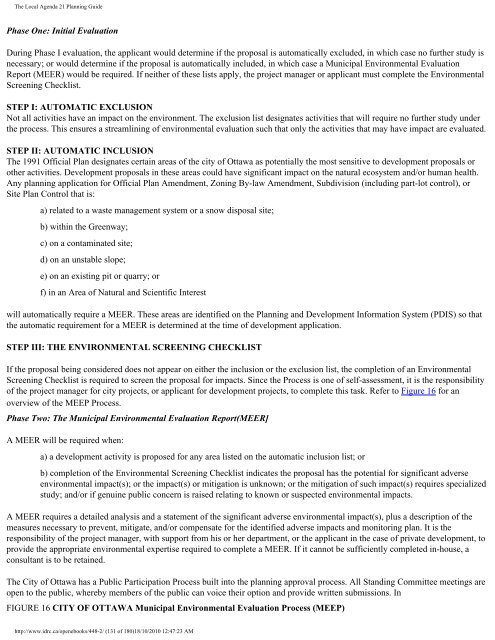The Local Agenda 21 Planning Guide - Democrats Against UN ...
The Local Agenda 21 Planning Guide - Democrats Against UN ...
The Local Agenda 21 Planning Guide - Democrats Against UN ...
You also want an ePaper? Increase the reach of your titles
YUMPU automatically turns print PDFs into web optimized ePapers that Google loves.
<strong>The</strong> <strong>Local</strong> <strong>Agenda</strong> <strong>21</strong> <strong>Planning</strong> <strong>Guide</strong><br />
Phase One: Initial Evaluation<br />
During Phase I evaluation, the applicant would determine if the proposal is automatically excluded, in which case no further study is<br />
necessary; or would determine if the proposal is automatically included, in which case a Municipal Environmental Evaluation<br />
Report (MEER) would be required. If neither of these lists apply, the project manager or applicant must complete the Environmental<br />
Screening Checklist.<br />
STEP I: AUTOMATIC EXCLUSION<br />
Not all activities have an impact on the environment. <strong>The</strong> exclusion list designates activities that will require no further study under<br />
the process. This ensures a streamlining of environmental evaluation such that only the activities that may have impact are evaluated.<br />
STEP II: AUTOMATIC INCLUSION<br />
<strong>The</strong> 1991 Official Plan designates certain areas of the city of Ottawa as potentially the most sensitive to development proposals or<br />
other activities. Development proposals in these areas could have significant impact on the natural ecosystem and/or human health.<br />
Any planning application for Official Plan Amendment, Zoning By-law Amendment, Subdivision (including part-lot control), or<br />
Site Plan Control that is:<br />
a) related to a waste management system or a snow disposal site;<br />
b) within the Greenway;<br />
c) on a contaminated site;<br />
d) on an unstable slope;<br />
e) on an existing pit or quarry; or<br />
f) in an Area of Natural and Scientific Interest<br />
will automatically require a MEER. <strong>The</strong>se areas are identified on the <strong>Planning</strong> and Development Information System (PDIS) so that<br />
the automatic requirement for a MEER is determined at the time of development application.<br />
STEP III: THE ENVIRONMENTAL SCREENING CHECKLIST<br />
If the proposal being considered does not appear on either the inclusion or the exclusion list, the completion of an Environmental<br />
Screening Checklist is required to screen the proposal for impacts. Since the Process is one of self-assessment, it is the responsibility<br />
of the project manager for city projects, or applicant for development projects, to complete this task. Refer to Figure 16 for an<br />
overview of the MEEP Process.<br />
Phase Two: <strong>The</strong> Municipal Environmental Evaluation Report(MEER]<br />
A MEER will be required when:<br />
a) a development activity is proposed for any area listed on the automatic inclusion list; or<br />
b) completion of the Environmental Screening Checklist indicates the proposal has the potential for significant adverse<br />
environmental impact(s); or the impact(s) or mitigation is unknown; or the mitigation of such impact(s) requires specialized<br />
study; and/or if genuine public concern is raised relating to known or suspected environmental impacts.<br />
A MEER requires a detailed analysis and a statement of the significant adverse environmental impact(s), plus a description of the<br />
measures necessary to prevent, mitigate, and/or compensate for the identified adverse impacts and monitoring plan. It is the<br />
responsibility of the project manager, with support from his or her department, or the applicant in the case of private development, to<br />
provide the appropriate environmental expertise required to complete a MEER. If it cannot be sufficiently completed in-house, a<br />
consultant is to be retained.<br />
<strong>The</strong> City of Ottawa has a Public Participation Process built into the planning approval process. All Standing Committee meetings are<br />
open to the public, whereby members of the public can voice their option and provide written submissions. In<br />
FIGURE 16 CITY OF OTTAWA Municipal Environmental Evaluation Process (MEEP)<br />
http://www.idrc.ca/openebooks/448-2/ (131 of 180)18/10/2010 12:47:23 AM










